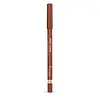What's inside
What's inside
 Key Ingredients
Key Ingredients

 Benefits
Benefits

 Concerns
Concerns

 Ingredients Side-by-side
Ingredients Side-by-side

Hydrogenated Palm Oil
EmollientHydrogenated Coco-Glycerides
EmollientMica
Cosmetic ColorantCaprylic/Capric Triglyceride
MaskingTripalmitin
Skin ConditioningTalc
AbrasivePropylparaben
PreservativeTocopherol
AntioxidantAscorbyl Palmitate
AntioxidantLecithin
EmollientGlyceryl Stearate
EmollientGlyceryl Oleate
EmollientCitric Acid
BufferingCI 77891
Cosmetic ColorantCI 77742
Cosmetic ColorantIron Oxides
CI 77007
Cosmetic ColorantCI 77510
Cosmetic ColorantCI 77289
Cosmetic ColorantCI 77288
Cosmetic ColorantTalc
AbrasiveCaprylic/Capric Triglyceride
MaskingZinc Stearate
Cosmetic ColorantPtfe
Ethylene/Acrylic Acid Copolymer
Emulsion StabilisingPolyethylene
AbrasivePolyethylene Terephthalate
Calcium Aluminum Borosilicate
Calcium Sodium Borosilicate
Sodium Dehydroacetate
PreservativePhenoxyethanol
PreservativeSynthetic Fluorphlogopite
Silica
AbrasiveSorbic Acid
PreservativeAlumina
AbrasivePolyurethane-33
Tin Oxide
AbrasivePolybutylene Terephthalate
Polylactic Acid
AbrasivePolymethyl Methacrylate
Acrylates Copolymer
Stearic Acid
CleansingCalcium Stearate
Cosmetic ColorantMagnesium Stearate
Cosmetic ColorantMica
Cosmetic ColorantCI 77891
Cosmetic ColorantCI 77491
Cosmetic ColorantCI 77492
Cosmetic ColorantCI 77499
Cosmetic ColorantCI 77742
Cosmetic ColorantCI 77007
Cosmetic ColorantCI 77163
Cosmetic ColorantCI 77400
Cosmetic ColorantCI 75470
Cosmetic ColorantCI 77000
Cosmetic ColorantCI 42090
Cosmetic ColorantCI 77510
Cosmetic ColorantCI 77288
Cosmetic ColorantCI 19140
Cosmetic ColorantCI 77289
Cosmetic ColorantTalc, Caprylic/Capric Triglyceride, Zinc Stearate, Ptfe, Ethylene/Acrylic Acid Copolymer, Polyethylene, Polyethylene Terephthalate, Calcium Aluminum Borosilicate, Calcium Sodium Borosilicate, Sodium Dehydroacetate, Phenoxyethanol, Synthetic Fluorphlogopite, Silica, Sorbic Acid, Alumina, Polyurethane-33, Tin Oxide, Polybutylene Terephthalate, Polylactic Acid, Polymethyl Methacrylate, Acrylates Copolymer, Stearic Acid, Calcium Stearate, Magnesium Stearate, Mica, CI 77891, CI 77491, CI 77492, CI 77499, CI 77742, CI 77007, CI 77163, CI 77400, CI 75470, CI 77000, CI 42090, CI 77510, CI 77288, CI 19140, CI 77289
Ingredients Explained
These ingredients are found in both products.
Ingredients higher up in an ingredient list are typically present in a larger amount.
This ingredient is an emollient, solvent, and texture enhancer. It is considered a skin-softener by helping the skin prevent moisture loss.
It helps thicken a product's formula and makes it easier to spread by dissolving clumping compounds.
Caprylic Triglyceride is made by combining glycerin with coconut oil, forming a clear liquid.
While there is an assumption Caprylic Triglyceride can clog pores due to it being derived from coconut oil, there is no research supporting this.
Learn more about Caprylic/Capric TriglycerideThis pigment is called Ultramarine blue lazurite. It gives a saturated blue color, but can be used to create other colors as well.
According to the manufacturer, it is usually made from kaolin, sodium sulfate, sodium carbonate, sulfur, and charcoal.
Ci 77288 is used to add green pigment to products.
We don't have a description for CI 77289 yet.
This ingredient is used to impart a blue color. It is not water-soluble.
It goes by two different names:
1. Ferric Ferrocyanide: a synthetic dark blue pigment
2. Ferric Ammonium Ferrocyanide: a synthetic blue pigment, also called Prussian blue
In the EU, both of these colors must be labeled as 'CI 77510'.
Learn more about CI 77510This ingredient is used to add a violet color to cosmetics.
It is created by reacting phosphoric acid, ammonium dihydrogen orthophosphate, and manganese dioxide.
Ci 77891 is a white pigment from Titanium dioxide. It is naturally found in minerals such as rutile and ilmenite.
It's main function is to add a white color to cosmetics. It can also be mixed with other colors to create different shades.
Ci 77891 is commonly found in sunscreens due to its ability to block UV rays.
Learn more about CI 77891Mica is a naturally occurring mineral used to add shimmer and color in cosmetics. It can also help improve the texture of a product or give it an opaque, white/silver color.
Serecite is the name for very fine but ragged grains of mica.
This ingredient is often coated with metal oxides like titanium dioxide. Trace amounts of heavy metals may be found in mica, but these metals are not harmful in our personal products.
Mica has been used since prehistoric times throughout the world. Ancient Egyptian, Indian, Greek, Roman, Aztec, and Chinese civilizations have used mica.
Learn more about MicaTalc is a clay mineral. It helps absorb moisture and improve the texture of products. Like other types of clay, Talc can have a slight exfoliating effect on skin. Talc can be added to increase the volume of products.
Some Baby powders are made by combining talc with corn starch. The word "talc" comes from Latin and originates from Arabic. Talc is a mineral commonly found throughout the world.
If you have any concerns about using talc, we recommend checking out the FDA's official page.
Learn more about Talc